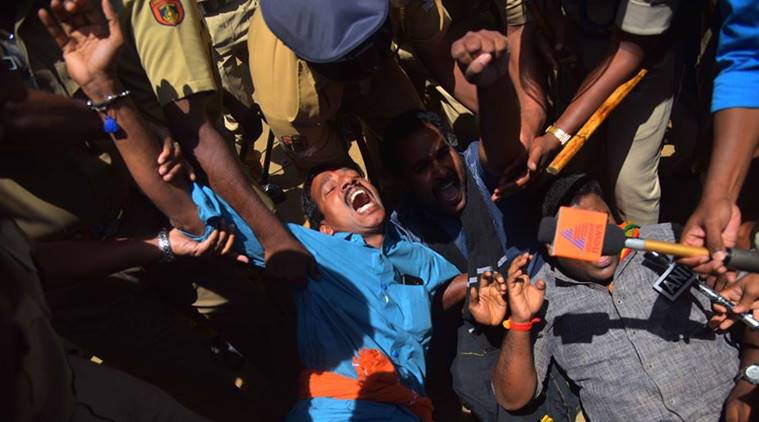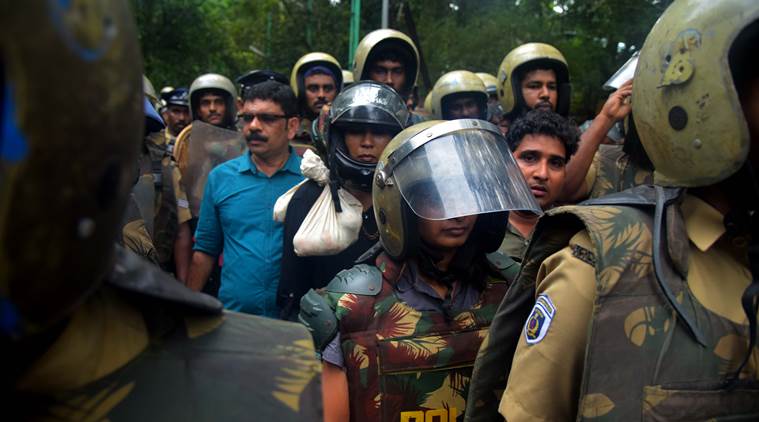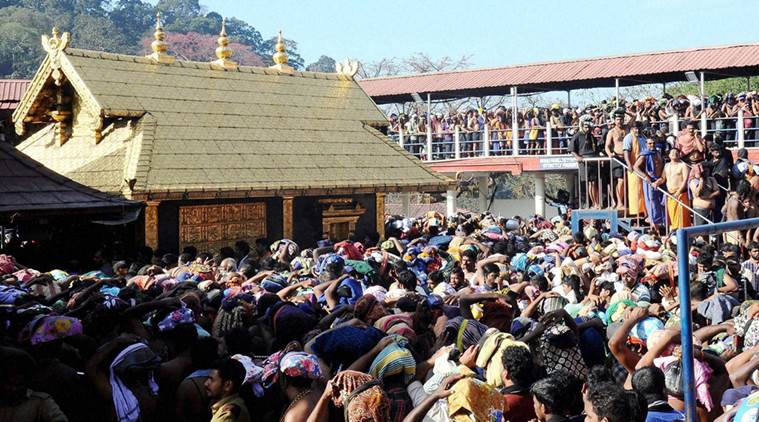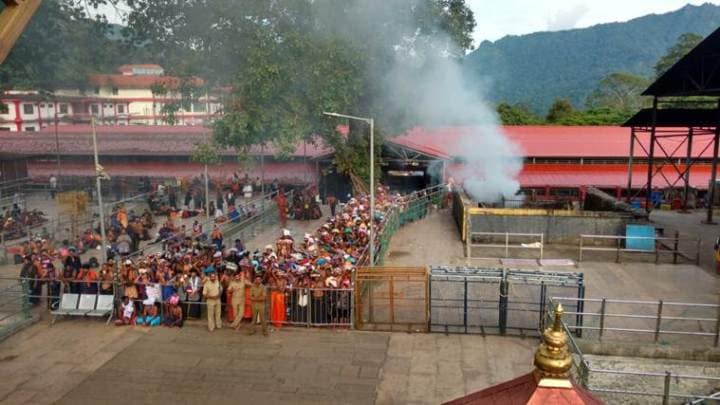Will Sabarimala rewrite the Kerala secular story?
The BJP’s only chance for any upward mobility from its present stagnation in Kerala is by gaining the support of more Hindu votes and the Sabarimala agitation offers a tailor-made opportunity to whip up communal passion.
Written by G Pramod Kumar
|
Updated: October 19, 2018 6:39:54 pm

X
BJP youth wing protesters during a protest at Nilakkal. (Express Photo by Vignesh)
Originally hailed as a historic decision, the recent Supreme Court verdict allowing entry of women of all ages to the famous Sabarimala
hill shrine in Kerala is turning out to be the cause of a major crisis
for the CPM-led Left Democratic Party (LDF). The socio-political
turbulence that the verdict has led to looks as politically significant
as the upper class “liberation struggle” against the first Communist
government in 1959.In 1959, the tumult that was spearheaded mainly by the Nairs and the Syrian Christians against educational reforms that the government of the day had proposed, led to the latter’s premature dismissal by the Centre. This time around, the CPM and the LDF have a strategy. They do want to play by the book and appear to be progressive, but not at the cost of losing a political edge. The Opposition – mainly the Congress and the BJP – are trying to retain their Hindu voters and also eat into each others’ support base by siding with the protesters.
Over the last few days, the main stopovers to Sabarimala from where the pilgrims begin their final forest trek to the shrine, and the places en route to the sanctum sanctorum (called “Sannidhanam” in Malayalam), have witnessed unprecedented violent religious protests. There was organised stone pelting and attacks on the police, public property and journalists. The state government and media called out the BJP and the RSS for the attacks. The RSS accused the government of infiltrating their “peaceful” protests to defame them.
Immediately after the Supreme Court announced its judgment on September 28, the Kerala government had announced that it would implement the verdict because it was the new law. The BJP and the Congress opposed it and said that the decision by the Constitutional Bench should be challenged. The two parties had a logically absurd argument: they said that they respected the Supreme Court verdict, but the traditional rituals and the sentiments of the devotees also needed to be respected. While the government was duty-bound to defend the Constitution, the BJP and Congress were bent upon reaping political capital from the issue.
 Hydrabad based jounalist Kavitha Jakkal and activist Rehna Fathima step
off shabarimala with police protection as they were not allowed to
enter sannidhanam. (Express Photo by Vignesh Krishnamoorthy)
When some women—reportedly journalists, devotees and activists—tried
to reach the shrine on the strength of the Supreme Court verdict on
Thursday, they faced violent resistance. Journalists were attacked even
at the transit points while devotees and activists had to abandon their
plans even when they had the support of armed police and commandos. The
closest thing to a flashpoint came on Friday, when two women – one an
activist from Kerala in pilgrim’s robes, and the other a journalist from
Andhra Pradesh – almost reached the entrance of the shrine. However,
they were opposed not just by the devotees, but the priests as well. The
priests said that if the women were allowed in they would close down
the temple. The police had to finally take the two women back.
Hydrabad based jounalist Kavitha Jakkal and activist Rehna Fathima step
off shabarimala with police protection as they were not allowed to
enter sannidhanam. (Express Photo by Vignesh Krishnamoorthy)
When some women—reportedly journalists, devotees and activists—tried
to reach the shrine on the strength of the Supreme Court verdict on
Thursday, they faced violent resistance. Journalists were attacked even
at the transit points while devotees and activists had to abandon their
plans even when they had the support of armed police and commandos. The
closest thing to a flashpoint came on Friday, when two women – one an
activist from Kerala in pilgrim’s robes, and the other a journalist from
Andhra Pradesh – almost reached the entrance of the shrine. However,
they were opposed not just by the devotees, but the priests as well. The
priests said that if the women were allowed in they would close down
the temple. The police had to finally take the two women back.The developments over the last few days, and on Friday, give a heads-up of what’s in store because presently the temple will stay open only for five days. The real pilgrimage season will begin in mid-November, when a few million from southern states will visit the temple over two months, and it will be impossible to control the crowds if such situations arise again. If the police was ineffective in dealing with the violence and vigilante behaviour by “devotees”- allegedly activists from the Sangh Parivar and affiliate organisations that included women – for a few days, would it be able to handle the situation when the scale is much bigger and for a much longer period? The forested terrain, near-stampede level crowds, and protesters motivated by religion and political motives could make it a dangerous situation.
In a massive crowd, it would he hard to tell a real pilgrim from a mischief-maker, and even the most sincere and careful intervention to uphold the law could lead to major mishaps. It could also be dangerous for women who try to visit the temple because the thick forests would allow trouble-makers to launch guerrilla-style attacks.
 s. The ruling CPM has no choice but to abide by the verdict, but the
eyes of the BJP and the Congress are on the possible political capital.
Given the situation, the Supreme Court verdict will have practical
value only if there is political consensus. The ruling CPM has no choice
but to abide by the verdict, but the eyes of the BJP and the Congress
are on the potential political capital. Clearly, the verdict is the
religious trigger that the BJP has been waiting for to scale up in a
state where polarisation of votes on communal lines has been very
difficult due to high political literacy.
s. The ruling CPM has no choice but to abide by the verdict, but the
eyes of the BJP and the Congress are on the possible political capital.
Given the situation, the Supreme Court verdict will have practical
value only if there is political consensus. The ruling CPM has no choice
but to abide by the verdict, but the eyes of the BJP and the Congress
are on the potential political capital. Clearly, the verdict is the
religious trigger that the BJP has been waiting for to scale up in a
state where polarisation of votes on communal lines has been very
difficult due to high political literacy.The Congress, on the other hand, cannot take any risks, because in addition to its traditional vote banks of Muslims and Christians, what keeps it afloat are the upper caste Hindus. The Sabarimala agitation was initiated by the upper caste Hindus, but soon became a pan-Hindu agitation cutting across castes. Hence, the Congress had no choice but to be on the protesters’ side, although the BJP rode it with all its resources. In the end, it was the Congress and the BJP on the side against the Constitution while the CPM, righteously stood alone in upholding it.
The political calculations are simple. The BJP’s only chance for any upward mobility from its present stagnant position is by gaining the support of more Hindu votes. The Sabarimala agitation offers a tailor-made opportunity to whip up communal passions. The Congress cannot afford any further erosion of their existing Hindu support base, and would also want to retrieve part of their recent loss of votes to the BJP. Besides splitting the BJP votes and winning back some voters, they also hope to wean away some of the Hindu votes of the CPM by being on the side of the agitators. The CPM’s major bloc of Hindu supporters are the Ezhavas (majority Hindus in the state), who constitute about 27 per cent of the population.
In simple terms, the BJP hopes get more Hindu votes from both the Congress and the CPM, while the Congress hopes to get back what it has already lost to the BJP and wean away Hindu votes from both the BJP and the CPM. Therefore essentially, the Congress and the BJP are playing the same politics while the CPM is sticking its neck out by taking a principled stand, possibly by betting on the secular mindset of the Malayalees. They also hope that such a neutral non-Hindu position will help wean some minority votes from the Congress camp.
 Devotees at the Sabarimala shrine. (Express photo by Vishnu Varma)
One has to wait till 2019 to see who wins this strategic battle.
Despite all the efforts being made, what will most probably keep the BJP
out will be Kerala’s unique demography. The state has only about 55 per
cent Hindus and to an gain electoral majority from them is impossible
because the historic division of their political patronage has been
between the Left parties and the Congress-led front. Gaining more than
15 per cent (the BJP’s vote share) of the Hindu votes will be a very
difficult task, except in a handful of pockets. So, the battle will be
between the Congress and the CPM. The CPM hopes that the communal
polarisation caused by the issue will lead to a split of its opposition
votes between the Congress and BJP, with the latter weaning more votes
than in the past from the former. The Congress hopes that by being a
proxy-BJP on the issue, it would gain both the BJP votes as well as
soft-Hindu – or rather Ezhava – votes from the CPM.
Devotees at the Sabarimala shrine. (Express photo by Vishnu Varma)
One has to wait till 2019 to see who wins this strategic battle.
Despite all the efforts being made, what will most probably keep the BJP
out will be Kerala’s unique demography. The state has only about 55 per
cent Hindus and to an gain electoral majority from them is impossible
because the historic division of their political patronage has been
between the Left parties and the Congress-led front. Gaining more than
15 per cent (the BJP’s vote share) of the Hindu votes will be a very
difficult task, except in a handful of pockets. So, the battle will be
between the Congress and the CPM. The CPM hopes that the communal
polarisation caused by the issue will lead to a split of its opposition
votes between the Congress and BJP, with the latter weaning more votes
than in the past from the former. The Congress hopes that by being a
proxy-BJP on the issue, it would gain both the BJP votes as well as
soft-Hindu – or rather Ezhava – votes from the CPM.Probably after watching how things panned out over the last few days, the government on Friday recalibrated its position by announcing that it would support only genuine pilgrims, and not activists. It also said that the shrine was meant for devotees and their beliefs, and not for activists to prove their strength. However, the biggest challenge will begin in mid-November if some women try to gain entry. Going by the decision on Friday, the government and the CPM are most likely to temper their stand with the lessons learned since the Supreme Court verdict, while the BJP will try its best not to lose the communal momentum it has gained. And the poor Congress, unfortunately, has no other choice but to imitate the BJP, because that’s what its expedience has landed itself in.


